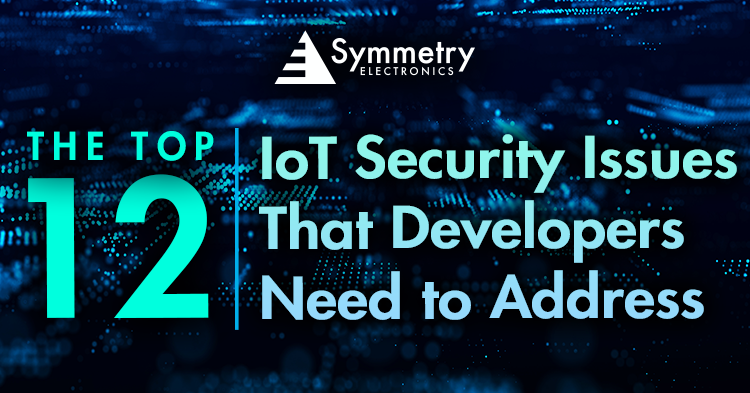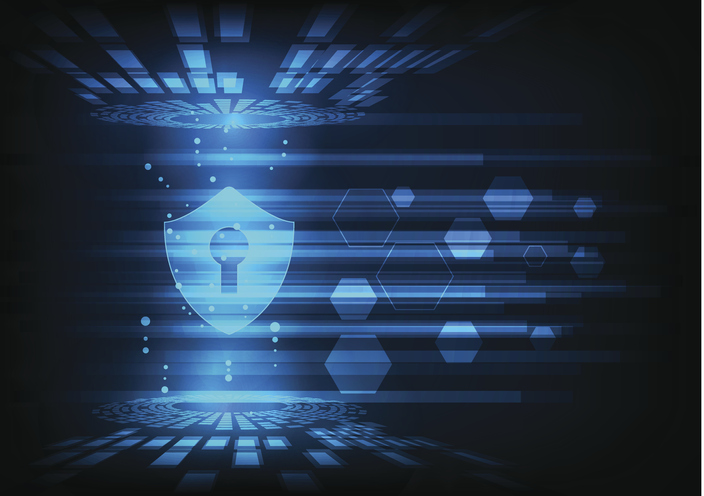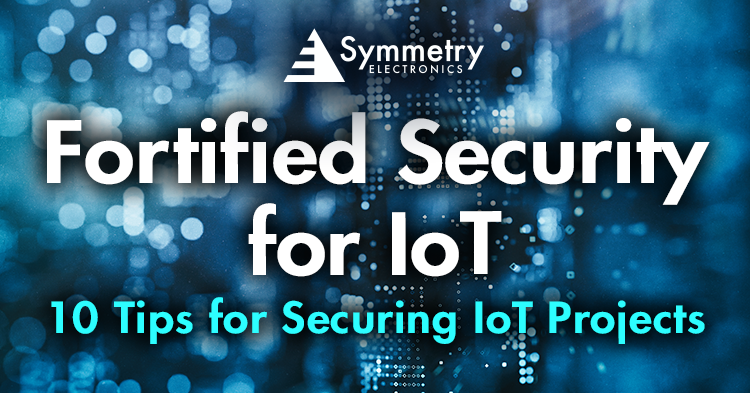- Home
- Symmetry Blog
- Top 12 IoT Security Issues that Developers Need to Address
Top 12 IoT Security Issues that Developers Need to Address
Monday, November 13, 2023

Why Should Developers Be Concerned About IoT Design Security?
Inherently, Internet of Things (IoT) devices and connected systems are susceptible to security breaches. According to IoT World Today, the number of IoT security breaches is on the rise. IoT cyberattacks more than doubled year-on-year during the first portion of 2021. From January to June of 2021, there were approximately 1.51 billion breaches of IoT devices as opposed to 639 million in 2020.
5 Reasons Why Connected Systems Are Susceptible to Cyberattacks
IoT security is a critical concern that developers must address to protect both their users and their own interests. Several concerns underscore the importance of prioritizing IoT security:
- The sheer scale of IoT devices: The widespread adoption of IoT devices across homes, workplaces, and public areas amplifies the potential for security vulnerabilities. As it stands, there are 14.76 billion IoT connected devices around the world. Developers must ensure that the software and firmware on these devices are not only secure but also resilient against potential cyberattacks.
- Lack of standardization: The absence of standardized IoT security measures leads to a diversity of security protocols among different devices. This lack of uniformity poses a challenge for developers striving to create secure and interoperable software.
- Critical infrastructure control: Given that IoT devices can control critical infrastructure like energy grids, transportation systems, and healthcare devices, a security breach can have catastrophic consequences. It is imperative to fortify these devices against hacking to prevent severe disruptions.
- Personal data privacy: IoT devices have the capability to amass sensitive personal data, including health, financial, and location information. Developers must prioritize safeguarding this data from unauthorized access and use it to uphold user privacy.
- Liability and reputation risks for developers: If an IoT device is hacked and causes damage or harm to a person or organization, the developer may be held liable. In addition, a security breach can damage a developer's reputation and result in financial losses.
Top 12 IoT Security Concerns
Microsoft’s 2021 paper, IoT Signals, outlines the top 12 IoT security issues (Figure 1) that developers should address in their designs:
1. Ensuring data privacy
Ensuring robust data privacy measures is a paramount concern for developers. Acknowledging privacy as a core design principle in the early design stages is crucial to developing a secure product. By prioritizing privacy in the design stage, developers can lay a foundation for a resilient and trustworthy IoT ecosystem.
In the quest for data privacy excellence, IoT developers must adopt a comprehensive approach to secure communication channels. The integration of encryption protocols, such as SSL/TLS, emerges as a pivotal strategy. This not only fortifies communication pathways between IoT devices and other interconnected systems but also acts as a robust deterrent against unauthorized access to sensitive data. The emphasis on secure communication underscores developers' commitment to safeguarding user information in an era where cyber threats continue to evolve.
Additionally, the integration of strong authentication methods Integrating strong authentication methods ensures that only authorized users or devices can access data. This can be achieved by implementing multi-factor authentication or biometric authentication.
- Developers should only collect and store data that is necessary for the operation of the IoT device. They should avoid collecting unnecessary data that could potentially be used for nefarious purposes.
- Data should be stored securely, whether it is stored locally or in the cloud.
2. Ensuring Network Level Security
Ensuring robust network-level security for IoT devices is critical. Developers recognize that the network, serving as the backbone of IoT ecosystems, demands vigilant safeguarding to thwart malicious activities and unauthorized access. Network security measures are paramount not only for protecting sensitive data but also for preserving the integrity and functionality of interconnected devices.
To fortify network-level security, developers employ a comprehensive set of techniques:
- Using Secure Communication Protocols: Employing encryption protocols, such as SSL/TLS, to fortify communication channels and protect data during transmission.
- Implementing Device Authentication Procedures: Enforcing robust authentication mechanisms to ensure that only authorized devices can access the network, mitigating the risk of unauthorized intrusions.
- Secure Firmware Updates: Regularly updating device firmware with security patches and enhancements to address vulnerabilities and reinforce the overall security posture.
- Network Segmentation: Dividing the network into segments to isolate and contain potential security breaches, preventing unauthorized lateral movement within the infrastructure.
- Regular Security Audits: Conducting routine audits to assess the network's security posture, identify vulnerabilities, and implement timely corrective measures.
- Physical Security: Implementing physical security measures to protect the physical infrastructure of IoT devices, such as securing access points and devices against tampering or unauthorized physical access.

3. Security Endpoints for Each IoT Device
Security endpoints play a pivotal role in fortifying IoT ecosystems, providing a boundary against cyber threats and ensuring the integrity of sensitive data. The incorporation of these endpoints is instrumental in maintaining robust protection against cyber attacks, shielding devices from potential breaches and unauthorized access. Furthermore, heightened security endpoints contribute significantly to upholding data privacy and confidentiality standards, safeguarding user information from compromise.
Moreover, the integration of security endpoints aligns with regulatory compliance requirements, ensuring that IoT systems adhere to established standards and frameworks. This adherence not only mitigates legal risks but also fosters a culture of responsible data management. Beyond regulatory considerations, security endpoints contribute to effective reputation management. In an era where a security breach can have severe repercussions on a company's standing, these endpoints become essential safeguards, preventing damage to the organization's reputation and erosion of customer trust.
The strategic inclusion of security endpoints also translates into tangible cost savings. By proactively addressing security concerns at the device level, developers can reduce the likelihood of security incidents that may incur financial losses. This cost-effective approach is a testament to the long-term value of robust security practices within the IoT ecosystem.
Strategies to enhance security endpoints:
- Implement robust authentication mechanisms.
- Employ encryption protocols for secure data transmission.
- Regularly update firmware and software to address vulnerabilities.
- Conduct comprehensive security audits and assessments.
- Establish and enforcing stringent access control policies.
4. Tracking and Managing Each IoT Device
Developers must track and manage every IoT device within a connected system stems from a holistic approach to system efficiency, reliability, and security. Tracking each device is crucial to ensuring they operate correctly and meet performance expectations, a fundamental aspect of maintaining the overall functionality of the interconnected ecosystem. By monitoring devices for updates and maintenance needs, developers can proactively address potential issues, minimizing downtime, and ensuring optimal performance. Additionally, tracking and managing IoT devices facilitate swift troubleshooting when issues arise, streamlining the resolution process and reducing the impact on system operations.
Furthermore, this approach contributes to system performance optimization and allows developers to identify bottlenecks, enhance efficiency, and deliver an improved user experience. Lastly, the data collection and analysis facilitated by tracking devices offer valuable insights into usage patterns, allowing developers to make informed decisions for future enhancements and optimizations.
Mitigation techniques for tracking and managing IoT devices within a connected system include:
- Implementing robust device monitoring and management tools.
- Establishing automated update and maintenance schedules.
- Conducting regular performance assessments and optimizations.
- Integrating real-time alert systems for issue detection.
- Utilizing analytics tools for comprehensive data collection and analysis.
5. Making Sure All Existing Software is Updated
Keeping software up to date is crucial for protecting IoT devices from security vulnerabilities. Software updates often include security patches and fixes that address known vulnerabilities and protect the devices from cyber attacks. Additionally, software updates also include bug fixes that improve device performance and stability. Developers can identify and fix bugs, improving the overall functionality of the device.
Strategies to ensure IoT software is up to date:
- Establish a systematic and automated software update process.
- Regularly monitor and apply security patches provided by software vendors.
- Conduct thorough testing of software updates to identify and address any compatibility issues.
- Provide clear and user-friendly instructions for end-users to encourage timely updates.
- Implement version control mechanisms to track and manage software changes effectively.
6. Updating Firmware and Other Software on Devices
Like software updates, firmware updates address known vulnerabilities and enhance security in IoT devices. Firmware updates also often include new features that can enhance the functionality of the device. IoT developers can add new features to their devices through firmware updates, providing users with a better experience.
Strategies to ensure firmware and software are up to date:
- Implement automated update mechanisms to streamline the deployment process.
- Conduct thorough testing and validation procedures before releasing updates to identify and rectify potential issues.
- Provide clear and user-friendly instructions for end-users to facilitate seamless updates.
- Establish secure communication channels for the secure transmission of firmware and software updates.
- Maintain a responsive and efficient customer support system to address user queries and concerns promptly.

7. Performing Hardware/Software Tests and Device Evaluation
IoT developers should focus on performing hardware/software testing and evaluation to ensure that devices meet required quality standards. Testing helps identify defects in hardware and software, improving the device's overall quality. In turn, enhanced quality connotes improved user experience. By testing devices with real users, developers can identify usability issues and make improvements.
How to evaluate IoT devices to meet quality standards:
- Implement comprehensive testing protocols covering both hardware and software components.
- Conduct thorough security assessments to identify and address vulnerabilities.
- Utilize real-world scenarios and environments in testing procedures.
- Regularly update firmware and software to address identified issues.
- Engage in continuous monitoring and evaluation throughout the device's lifecycle.
8. Updating Encryption Protocols
Encryption protocols are critical for protecting IoT devices from security threats. Updating encryption protocols can further protect devices from new threats. Updating encryption protocols can also improve the longevity of IoT devices. As technology evolves, older encryption protocols may become obsolete, leaving devices vulnerable to security threats. Updating encryption protocols can help future-proof devices and protect them from new threats.
How to make sure encryption protocols are up to date:
- Regularly monitor and stay informed about emerging encryption standards.
- Implement automated processes for timely encryption protocol updates.
- Conduct thorough risk assessments to identify vulnerabilities associated with outdated protocols.
- Collaborate with industry experts and participating in security communities to stay abreast of best practices.
- Employ a phased approach to ensure a smooth transition and minimal disruption during protocol updates.
9. Comprehensive Training Programs for Employees Involved in an IoT Environment
While IoT developers aren’t ultimately responsible for workplace training involved in implementing their solutions, they are responsible for the usability and accessibility of their equipment. IoT devices are often designed to be easy to use and integrate into a workplace environment. Training can help users understand how to use the devices properly and optimize their performance, leading to a better user experience.
How to conduct comprehensive IoT training programs:
- Develop user-friendly instructional materials and documentation.
- Conduct hands-on training sessions and workshops.
- Implement an ongoing support system for users to address queries and challenges.
- Provide online training modules for remote accessibility.
- Collaborate with organizations to tailor training programs to specific workplace needs.

10. Securely Provision Devices
Securely provisioning IoT devices is essential for security, identity and access management, compliance, data privacy, and firmware and software updates. IoT developers should ensure that their devices are provisioned securely to reduce the risk of security threats and protect the privacy of individuals and organizations.
Strategies to ensure IoT devices are securely provisioned:
- Implement secure boot processes.
- Enforce robust access control measures.
- Employ device authentication mechanisms.
- Utilize secure communication protocols during provisioning.
- Regularly update and patch provisioning systems to address vulnerabilities.
11. Shifting from Device-Level to Identity-Level Control
Identity-level control allows for better security measures, such as two-factor authentication and access control lists, that can help prevent unauthorized access to IoT devices and networks. Additionally, device-level control can be difficult to manage as the number of devices in a network increases. Identity-level control provides a more scalable solution by allowing administrators to manage access to a group of devices based on the identities of the users who need access.
Strategies to transition form device-level to identity-level control:
- Implement two-factor authentication mechanisms.
- Employ access control lists to define and manage user permissions.
- Utilize robust identity management solutions.
- Establish and enforce strong password policies.
- Regularly review and update access privileges based on user roles and responsibilities.
12. Changing Default Passwords/Credentials
Changing passwords and credentials is a critical aspect of IoT security, as it helps to reduce the risk of unauthorized access to IoT devices and networks. Additionally, regularly changing passwords and credentials helps protect against credential stuffing attacks and reduces the risk of password leaks.
Password and credential best practices:
- Implement a secure and user-friendly password change process.
- Enforce strong password policies, including complexity requirements.
- Educate users on the importance of changing default credentials.
- Periodically prompt users to update passwords.
- Employ secure and unique credentials for each device.
The Future of Fortified IoT Security
As the number of connected devices worldwide continues to surge, the vulnerabilities inherent in the sheer scale of IoT deployment necessitate a proactive and comprehensive approach to cybersecurity. Developers are compelled to prioritize security considerations across various dimensions, including data privacy, network-level security, device tracking, software and firmware updates, hardware/software testing, and the adoption of robust encryption protocols. By focusing on these facets, developers not only safeguard users and their own interests but also contribute to the creation of resilient and trustworthy IoT ecosystems.
Interested in enhancing your IoT design’s level of security? Our team of Applications Engineers are experts in IoT, IIoT, and connected systems and are available to assist you in integrating next generation security innovations in your IoT design. Consultation is free and available throughout your design cycle. Contact Symmetry Electronics today!

.png)